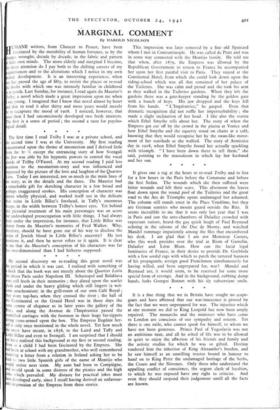My second discovery on re-reading this great novel was he
period in which it was cast. I realised with something of shock that the book was not merely about the Quartier Latin t about Paris under Napoleon III. Sebastopol and Balaklava ere still fresh in their memories ; they dined upon the scarlet lush and under the heavy gilding which still lingers (a wel- ome anachronism) in the grill-room of our own Cafe Royal ; hey wore top-hats when they crossed the river ; the hall of ° Continental or the Grand Hotel was in those days the true centre of elegance as in later years the gallery of the az ; and along the Avenue de l'Imperatrice passed the namelled carriages with the footmen in their huge fur-tippets aing cross-armed upon the box. The Empress Eugenie her- elf is only once mentioned in the whole novel. Yet how much he must have meant, in 1858, to the Laird and Taffy and ittle Billee and even to Svengali. I am surprised that I should t have realised this background at my first or second reading. yen as a child I had been fascinated by the Empress. She d been at school with my grandmother, who well remembered eceiving a letter from a relation in Ireland asking her to be nd to two little Spanish girls of the name of Montijo who ould arrive next term. My aunt had been to Compiegne, d would speak in some distress of the picnics and the high mks whiCh prevailed. My distaste for practical jokes must ve developed early, since I recall having derived an unfavour- e impression of the Empre,ss from these stories.


























 Previous page
Previous page